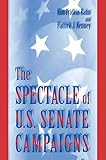The Spectacle of U.S. Senate Campaigns / Patrick J. Kenney, Kim Fridkin Kahn.
Material type: TextPublisher: Princeton, NJ : Princeton University Press, [2022]Copyright date: ©1999Description: 1 online resource (256 p.)Content type:
TextPublisher: Princeton, NJ : Princeton University Press, [2022]Copyright date: ©1999Description: 1 online resource (256 p.)Content type: - 9780691227924
- Elections -- United States
- Political campaigns -- United States
- POLITICAL SCIENCE / Political Process / General
- Ad Watches
- Adams, John Quincy
- Arizona Republic
- Birmingham News
- Boxer, Barbara
- Bush, George
- Campaign Hotline
- Cook Report
- Daily Progress
- Dallas Daily News
- DeGreen, Keith
- Durenberger, Dave
- Friedrich, Robert J
- Goldwater, Barry
- Gutmann, Amy
- Honolulu Advertiser
- Houston Chronicle
- Indianapolis Star
- Jeffords, James M
- Johnson, Brook
- Kassebaum, Nancy Landon
- Kerrey, Robert
- Kingdon, John
- Lloyd-Jones, Jean
- Miami Herald
- Minneapolis Star-Tribune
- Reagan, Ronald
- Rockefeller, John D
- San Francisco Chronicle
- Seattle Times
- Thurmond, Strom
- Voinovich, George
- Weicker, Lowell P
- Wellstone, Paul
- Williams, Dick
- Wyman, Jasper
- campaign spending
- candidate strategies
- competition
- early polls
- economic issues
- environmental issues
- feeling thermometer
- gender of candidates
- health issues
- ideology: of candidates
- incumbency advantage
- negativity: by candidates
- partisan differences
- party identification
- seniority of senator
- viability
- voters’ survey
- 324.7/0973 21
- JK2281
- JK2281 .K24 1999
- online - DeGruyter
| Item type | Current library | Call number | URL | Status | Notes | Barcode | |
|---|---|---|---|---|---|---|---|
 eBook
eBook
|
Biblioteca "Angelicum" Pont. Univ. S.Tommaso d'Aquino Nuvola online | online - DeGruyter (Browse shelf(Opens below)) | Online access | Not for loan (Accesso limitato) | Accesso per gli utenti autorizzati / Access for authorized users | (dgr)9780691227924 |
Frontmatter -- Contents -- List of Figures -- List of Tables -- Acknowledgments -- Part One: Understanding And Measuring Campaigns -- One. The Nature of Political Campaigns -- Two. Measuring the Content and Consequences of Political Campaigns -- Part Two. The Campaign Strategies Of Candidates -- Three. In Order to Win: An Examination of Campaign Strategies -- Four. Attack Politics: Understanding the Determinants of Negative Campaigning -- Part Three. The News Media's Coverage Of Campaigns -- Five. Deciding What Is News: The Media's Coverage of Senate Campaigns -- Six. The Struggle for Control over the News Media's Agenda: How Candidates Influence the Content and Tone of News Coverage -- Part Four: Citizens' Reactions To Campaigns -- Seven. The Dynamics of Competition: The Impact of the Candidates and the News Media -- Eight. Citizens' Knowledge about U.S. Senate Campaigns -- Nine. How Voters Make Decisions in U.S. Senate Campaigns -- Part Five: Conclusions -- Ten. Conclusions and Implications -- Appendixes -- A. Interview Schedule for Successful Incumbents -- B. Political Advertising Code Sheet -- C. Sample of Newspapers -- D. Newspaper Content Analysis Code Sheet -- References -- Index
restricted access online access with authorization star
http://purl.org/coar/access_right/c_16ec
This book offers a bold, comprehensive look at how campaigns actually work, from the framing of issues to media coverage to voters' decisions. In so doing, it challenges the common wisdom that campaigns are a noisy, symbolic aspect of electoral politics, in which the outcomes are determined mainly by economic variables or presidential popularity. Campaigns, the authors argue, do matter in the political process. Examining contested U.S. Senate races between 1988 and 1992, Kim Kahn and Patrick Kenney explore the details of the candidates' strategies and messages, the content, tone, and bias of the media coverage, and the attitudes and behaviors of potential voters. Kahn and Kenney discover that when the competition between candidates is strong, political issues become clearly defined, and the voting population responds. Through a mix of survey data, content analysis, and interviews, the authors demonstrate how competition influences serious political debates in elections. Candidates take stands and compare themselves to their opponents. The news media offer more coverage of the races, presenting evaluations of the candidates' positions, critiques of their political careers, and analyses of their campaign ads. In response, the voters pay closer attention to the rhetoric of the candidates as they learn more about central campaign themes, often adjusting their own voting criteria. The book concentrates on Senate races because of the variance in campaign strategy and spending, media coverage, and voter reactions, but many of the findings apply to elections at all levels.
Mode of access: Internet via World Wide Web.
In English.
Description based on online resource; title from PDF title page (publisher's Web site, viewed 29. Jul 2022)


